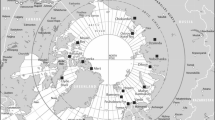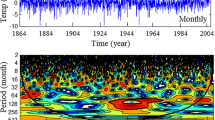Abstract
A wavelet-based methodology is applied to relevant climatic indices and air temperature records and allow to detect the existence of unexpected cycles. The scale spectrum shows the presence of two cycles of about 30 and 43 months, respectively, in the air–temperature time series, in addition to the well-known cycles of 1 day and 1 year. The two cycles do not affect the globe uniformly: some regions seem to be more influenced by the period of 30 months (e.g. Europe), while other areas are affected by the period of 43 months (e.g. North-West of the USA). Similar cycles are found in the indices and the regions influenced by these indices: the NAO index and the Western Europe display a cycle of 30 months, while the cycle of 43 months can be found in the ENSO index and in regions where it is known to have an impact.














Similar content being viewed by others
References
Arneodo A, Grasseau G, Holschneider M (1988) Wavelet transform of multifractals. PRL 61:2281–2287
Arneodo A, d’Aubenton Carafa Y, Bacry E, Graves P, Muzy J, Thermes C (1996) Wavelet based multifractal analysis of DNA sequences. Phys D 96:291–320
Arneodo A, Audit B, Decoster N, Muzy J, Vaillant C (2002) Climate disruptions, market crashes and heart attacks. In: Bunde A, Schellnhuber H (eds) The science of disasters. Springer, Berlin, pp 27–102
Baldwin MP et al (2001) The quasi-biennial oscillation. Rev Geophys 39:179–229
Barnston A, Livezey R (1987) Classification, seasonality and persistence of low-frequency atmospheric circulation patterns. Mon Weather Rev 115:1083–1126
Berdyugina SV, Usoskin IG (2003) Active longitutes in sunspot activity: century scale persistence. Astron Astrophys 405:1121
Brohan P, Kennedy JJ, Harris I, Tett SFB, Jones PD (2006) Uncertainty estimates in regional and global observed temperature changes: a new dataset from 1850. J Geophys Res 111:D12,106
Daubechies I (1992) Ten lectures on wavelets. SIAM, Philadelphia
Fedorov AV, Philander SG (2000) Is El Niño changing? Science 288:1997–2002
Goupillaud P, Grossman A, Morlet J (1984) Cycle-octave and related transforms in seismic signal analysis. Geoexploration 23:85–102
Hansen J, Ruedy R, JG, Sato M (1999) GISS analysis of surface temperature change. J Geophys Res 104:30,997–31,022
Hurrell JW (1995) Decadal trends in the North Atlantic Oscillation: regional temperatures and precipitation. Science 269:676–679
Jones P, Osborn TJ, Briffa KR, Folland CK, Horton EB, Alexander LV, Parker DE, Rayner NA (2001) Adjusting for sampling density in grid box land and ocean surface temperature time series. J Geophys Res 106:3371–3380
Kalnay E et al (1996) Ncep/Ncar 40-year reanalysis project. Bull Am Meteor Soc 77:437–471
Keller W (2004) Wavelets in geodesy and geodynamics. Gruyter, Berlin
Klein Tank AMG et al (2002) Daily dataset of 20th-century surface air temperature and precipitation series for the European climate assessment. Int J Climatol 22:1441–1453
Kronland-Martinet R, Morlet J, Grossmann A (1987) Analysis of sound patterns through wavelet transforms. Int J Pattern Recogn Artif Intell 1:273–302
Mallat S (1999) A wavelet tour of signal processing. Academic Press, New-York
Mantua NJ, Hare SR, Zhang Y, Wallace JM, Francis RC (1997) A pacific interdecadal climate oscillation with impacts on salmon production. Bull Am Meteorol Soc 78:1069–1079
Meyer Y (1989) Ondelettes et opérateurs. Hermann, Paris
Mursula K, Hiltula T (2004) Systematically asymmetric heliospheric magnetic field: evidence for a quadrupole mode and non-axissymmetry with polarity flip–flops. Sol Phys 224:133–143
Nelder J, Mead R (1965) A simplex method for function minimization. Comput J 7:308–313
Newton H, Milsom A (1955) Note on the observed differences in spottedness of the Sun’s Northern and Southern Hemispheres. Monthly Not R Astron Soc 115:398:404
Nicolay S, Argoul F, Touchon M, d’Aubenton Carafa Y, Thermes C, Arneodo A (2004) Low frequency rhythms in human DNA sequences: a key to the organization of gene location and orientation? PRL 93:108,101
Paluš M, Novotná D (2008) Detecting oscillations hidden in noise: common cycles in atmospheric, geomagnetic and solar data. In: Donner R, Barbosa S (eds) Nonlinear time series analysis in geosciences: applications in climatology, geodynamics and solar–terrestrial physics. Springer, Berlin, pp 327–353
Paluš M, Novotná D (2006) Quasi-biennal oscillations extracted from monthly NAO index and temperature records are phase-synchronized. Nonlinear Proc Geophys 13:287–296
Rayner NA, Brohan P, Parker DE, Folland CK, Kennedy JJ, Vanicek M, Ansell TJ, Tett SFB (2006) Improved analyses of changes and uncertainties in sea surface temperature measured in situ since the mid-nineteenth century: the HadSST2 dataset. J Clim 19:446–469
Schwing F, Murphree T, Green P (2002) The northern oscillation index (NOI): a new climate index for the northeast pacific. Prog Oceanogr 53:115–139
Takalo J, Mursula K (2002) Annual and solar rotation periodicities in IMF components: evidence for phase/frequency modulation. Geophys Res Lett 29:31–1–31–4
Trenberth K, Hurrell JW (1994) Decadal atmosphere–ocean variations in the pacific. Clim Dyn 9:303–319
Wolter K, Timlin MS (1993) Monitoring ENSO in coads with a seasonally adjusted principal component index. In: Proceedings of the 17th climate diagnostics workshop, Norman, OK, NOAA/N MC/CAC, NSSL, Oklahoma Clim Survey, CIMMS and the School of Meteor 52–57
Wolter K, Timlin MS (1998) Measuring the strength of ENSO events–how does 199798 rank. Weather 53:315–324
Zhang Y, Wallace JM, Battisti DS (1997) ENSO-like interdecadal variability. J Clim 10:1004–1020
Zhou S, Miller AJ, Wang J, Angell JK (2001) Trends of NAO and AO and their associations with stratospheric processes. Geophys Res Lett 28:4107–4110
Author information
Authors and Affiliations
Corresponding author
Rights and permissions
About this article
Cite this article
Nicolay, S., Mabille, G., Fettweis, X. et al. 30 and 43 months period cycles found in air temperature time series using the Morlet wavelet method. Clim Dyn 33, 1117–1129 (2009). https://doi.org/10.1007/s00382-008-0484-5
Received:
Accepted:
Published:
Issue Date:
DOI: https://doi.org/10.1007/s00382-008-0484-5




